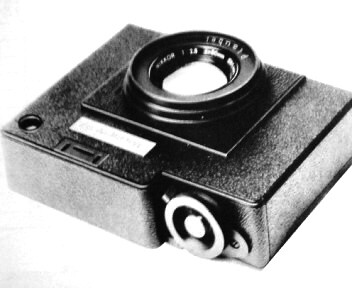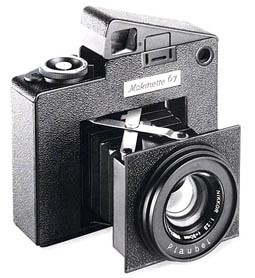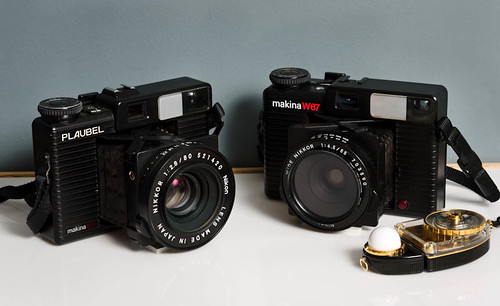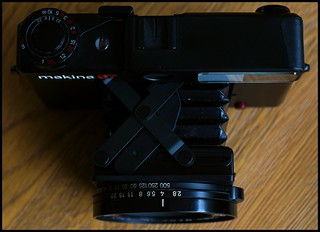Makina 67
The Makina 67 is a 6×7 strut folding camera with a coupled rangefinder. It was developed by Plaubel after the company was bought in 1975 by a Japanese company named Doi.
Contents
Development and production
Makinette 67
The Makina 67 was first shown as a prototype "Makinette 67" at Photokina 1976, quite different from the production model. The most noticeable functional difference is the patented viewfinder (US 4166682 A), which would pop up when the lens was pulled out to the infinity setting, and fold into the camera body when the lens was retracted. The purpose was to minimize the dimensions of the camera in the folded state, while providing an unobstructed viewfinder. In the end this concept was not used, making the final design noticeably wider. Further patents were applied for by Goetz Schrader (the previous Plaubel owner, and CEO until 1984) in september 1976, in time for the Photokina launch. This includes the scissor linkage (US 4171891 A), shutter release (US 4166686 A) and adjusting and latching mechanism (US 4146320 A).

|
| Plaubel Makinette 6x7 prototype closed image by Plaubel (Image rights) |

|
| Plaubel Makinette 6x7 prototype open image by Plaubel (Image rights) |
Plaubel Makina 67

|
| Plaubel Makina 67 image by Bellamy (Image rights) |
Kimio Doi, of the Doi Group, requested a redesign of the Makinette 67 from Konica, lead by chief designer Yasuo Uchida (previously designer of the 1975 Konica C35 EF). Doi also prioritized the exterior design, and asked professor Udo M. Geissler, from the industrial design department of the Munich University of Applied Sciences[1], for help. Yasuo Uchida then went to Munich to consult with Geissler[2]. The design principles were to create a camera that could 1) take good pictures and 2) be easy to use. Regarding picture quality, the "Doi International Design Department" emphasized that the lens must be excellent and that the camera should use medium format film. The 6x7 format was chosen as the ideal format for prints. Furthermore the rangefinder, exposure meter and other camera parts were designed to be highly durable, ensuring high image quality. As for ease of use, the designers emphasized compactness and light weight for convenient carrying. Priority was also put on making the camera easy to hold and operate, including making the wind lever ergonomic and the size and placement of buttons.[3].
In a 2015 interview, the chief designer, Yasuo Uchida, stated that he disagreed with Geissler on some parts of the exterior design, and had them adjusted. They also argued about the size of the lens face, which Uchida wanted to keep as small as possible, while Geissler wanted as large as possible. Geissler refused to budge, and Uchida yielded in the end. In retrospect Uchida considerds the lens face one of the Makina 67's distinguishing features, stating that the exterior design is a key factor of the camera, and regards Geissler's work as "amazing"[4][5].
Doi furthermore wanted to make the Makina 67 an automatic exposure camera, which was a trend at the time. However Uchida refused, as he felt that it was a camera for professionals using slide film, where correct exposure is critical, and AE was not accurate enough in this regard. In the end a manual exposure meter was used. Uchida, from Konica, also requested Doi to use a Konica lens for the camera. However Kimio Doi disagreed, having already paid Nikon for the development of the 80mm f2.8 lens specially for the Makina (or rather Makinette 67 at that time), after taking over Plaubel. Uchida asked for a copy of the lens for testing, and agreed to use it after being satisfied with the results. Besides the external design, Uchida now considers the Nikkor lens a distinguishing feature of the camera.[6][7]
The redesigned Makina 67 was first shown at Photokina 1978, and was released in March 1979.[3] The camera's shape is reminiscent of the Makinette 6x7 prototype, but also the earlier Makina. After the redesign it also closely resembles the Agfa Optima Sensor Series, for which either professor Geissler or his colleague, professor Norbert Schlagheck, seems to have provided the design through the design firm Schlagheck & Schultes. The similarities with the Agfa camera was also noted in a contemporary Japanese review, pointing out the German roots of the designer, while characterizing it as a roundish, soft and elegant european design.[3]
The production Makina 67 bodies were made in Japan by Konica. They have the aforementioned Nikkor 80/2.8 lens.
Further development
The Makina W67 followed, announced at the 1981 PMA, with a specially designed Nikkor 55/4.5 wide angle lens and some changes to the design including a ribbed body, rubber ring on the focusing dial, smaller front face and a rectangular rangefinder window instead of round. The new body features were later used for an update of the original camera in 1984, called the Makina 670, which however kept the large lens face, but changed the red front face button to a "neutral" black one. The changes to the W67 and 670 cameras arguably are to the detriment of the original design signature of the Makina 67.
At the 1982 Photokina Plaubel showed a prototype of a Makina Instant camera using instant-film packs, based on the Makina 67 and 67W. It had a simpler 90mm f3.5 lens with 4 elements in 3 groups, a Copal shutter, rangefinder focusing and built in exposure meter[8]. It seems never to have gone beyond the prototype stage.

|
| Plaubel Makina 670 and Makina W67 wide-angle model image by Professor Jones (Image rights) |
Notes
- ↑ http://nikomat.org/priv/camera/mednikkor/makina/makina-e.html
- ↑ https://www.youtube.com/watch?v=fynKqJ0Ohes
- ↑ 3.0 3.1 3.2 Shashin Kōgyō (Photographic Industries) Vol. 37, No. 6 (1979) pp 64-74.
- ↑ https://www.youtube.com/watch?v=fynKqJ0Ohes
- ↑ https://www.instagram.com/p/BJx-R8oBMj2/
- ↑ https://www.youtube.com/watch?v=fynKqJ0Ohes
- ↑ https://www.instagram.com/p/BJx-R8oBMj2/
- ↑ Popular Photography jan 1983 p. 102
Bibliography
- Lewis, Gordon, ed. The History of the Japanese Camera. Rochester, N.Y.: George Eastman House, International Museum of Photography & Film, 1991. ISBN 0-935398-17-1 (paper), 0-935398-16-3 (hard). P. 154.
- McKeown, James M. and Joan C. McKeown's Price Guide to Antique and Classic Cameras, 12th Edition, 2005-2006. USA, Centennial Photo Service, 2004. ISBN 0-931838-40-1 (hardcover). ISBN 0-931838-41-X (softcover). P. 789.
- Sugiyama, Kōichi (杉山浩一); Naoi, Hiroaki (直井浩明); Bullock, John R. The Collector's Guide to Japanese Cameras. 国産カメラ図鑑 (Kokusan kamera zukan). Tokyo: Asahi Sonorama, 1985. ISBN 4-257-03187-5. Items 1397–8 and 1400.
Links
In English:
- Makina 67 (also in Japanese) in Hiura Shinsaku's camera site
- Makina 67 and sales brochure in Ken Rockwell's website
- Makina 67 review by Rob Gardiner
- Makina 67 (brief summary and archived bulletin-board discussions) at an archived version of Robert Monaghan's Medium Format Photography website, at the Internet Archive.
- Makina 67 PDF manual in multiple languages from OrphanCameras.com website.
In French:
In Japanese:
